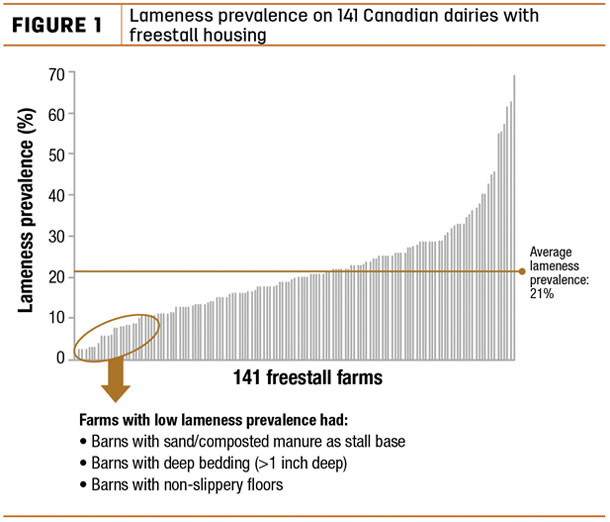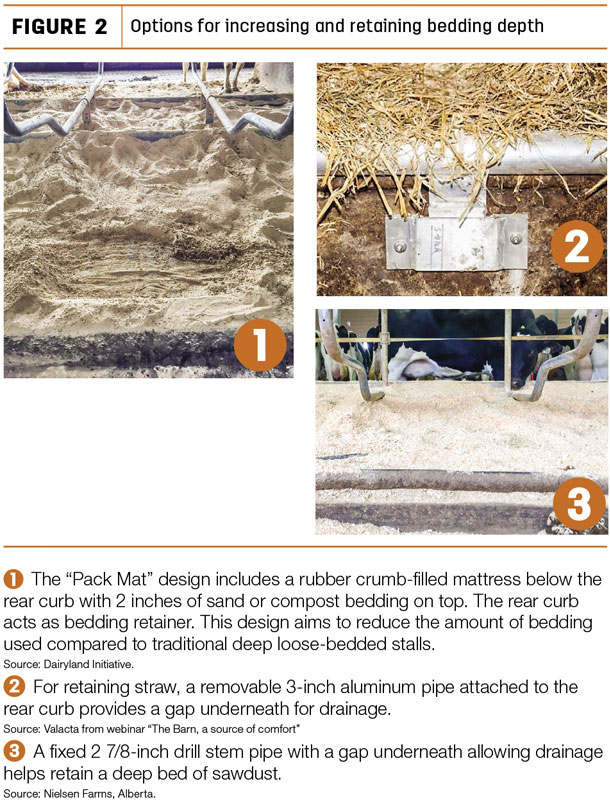In addition to being detrimental for cows’ longevity, reproductive performance and production, lameness is our dairy industry’s most visible animal welfare issue. We face increasing pressures from the public to ensure our cows are well cared for.
In response to concerns regarding animal well-being, the dairy industry worldwide has developed regulations and requirements, with lameness being one of the areas commonly assessed.
Regardless of whether the goal is to satisfy consumers, to comply with regulations, to limit economic losses or to provide the best care for our cows, lameness can be reduced in most herds without requiring a major investment in facility renovation.
Is there a catch-all strategy to decrease lameness?
Lameness is multifactorial, with a long list of risk factors and an even longer list of options for control and prevention. Those options include functional hoof trimming, early detection and treatment, improved environmental hygiene, strategic foot bathing, better transition cow management, stress-free handling and, very importantly, optimal cow comfort.
To achieve the latter, we need to provide adequate ventilation, water and light; control stocking density; and improve the comfort of walking, standing and resting surfaces.
A bit overwhelming, isn’t it? Based on scientific evidence, we’ll emphasize a couple of changes you can consider in your facilities to improve cow comfort and reduce lameness.
Not many of my cows are lame ...
Let’s first acknowledge that farmers often underestimate how many of their cows are lame. On average, a farmer will recognize only a third of the lame cows that a trained person will identify in the same herd. This doesn’t necessarily mean farmers don’t perceive lameness as an issue or that they don’t monitor their cows. The reality is detecting lame cows can be challenging.
We need to think of lameness in the same way as we do mastitis. Clinical mastitis is only the “tip of the iceberg,” but subclinical mastitis is far more common and costly. In the same way, severely lame cows are the tip of the iceberg; they are obvious and easy to detect.
But mildly lame cows (gait score 3 on a 1-to-5 scale), those with a slight limp are the tricky ones because they are not so easy to detect but far more common and costly.
More importantly, mildly lame cows are where most of our efforts for lameness control and prevention should focus, as they are the most likely to successfully recover if treated. With that in mind, if you think that less than 10 percent of your herd is lame, take a closer look … you may find there are far more lame cows than expected.
Then how do we solve our lameness issue?
Approach solving the issue in the same way as for any other complex problem: Break it down into smaller problems. For the sake of this article, let’s focus on cow comfort, as it is critical not only for lameness development, but also for lameness recovery. As part of a Canada-wide cow comfort study, we visited more than 140 freestall farms and evaluated more than 5,600 cows to investigate which risk factors were associated with lameness.
We spent five to eight hours on each farm collecting data on dozens of factors that can affect lameness, related to individual cows, management practices and facility design. Average lameness prevalence was 21 percent, but as expected, there was large variation among farms. In some farms, less than 5 percent of cows were lame, but in others, up to 65 percent were lame (see Figure 1).

What were the farms with low lameness prevalence doing differently? In general, they provided more comfortable lying and walking surfaces by using sand or dried manure as the stall base, by having deep-bedded stalls and by maintaining non-slippery floors.
It doesn’t mean we can forget about the many other factors that play a role in cow comfort and lameness, but it means we have good evidence to support changes made to the stall bedding depth and flooring slipperiness. We know sand (when managed correctly) is the gold standard when it comes to cow comfort.
Unfortunately, sand is not popular among Canadian dairies (used by only about 10 percent), probably due to perceived challenges related to availability, manure handling and weather conditions.
The good news is: If you don’t want to or can’t switch to sand or dried manure, you can always increase the quantity of bedding in the stalls, and you’ll see the positive impact this change will have on lameness, hock and knee injuries – and even leg hygiene.
It is also important to highlight no differences were found among the various types of stall base (geo/gel mattress, rubber, waterbed, etc.) or bedding (wood shavings, straw, sawdust, etc.), meaning that regardless of the type of stall base and bedding, increasing quantity and depth of bedding is a good starting point to decrease lameness.
Of course, make sure bedding is not abrasive. (For example, there should be no big, sharp wood chunks.) Deep, loose bedding will encourage lying while providing cushioning, traction and a clean, dry lying surface.
If you are still not convinced making changes to stall bedding can result in decreased lameness and fewer hock and knee injuries, results from a follow-up study provide more evidence. This study compared lameness, hock and knee injuries and average lying time among 15 farms that had participated in the above-mentioned cow comfort study and made a change to their facilities after the assessment.
An additional 30 farms had either participated in the earlier study and did not make any changes to their facilities or had never been evaluated for cow comfort. The farms that made changes to their facilities had, on average, 8 to 11 percent less lameness, 3 to 6 percent less body injuries and 1.9 to 2.4 more hours per day of lying time than the other farms.
Can you guess what specific changes these farms made to their facilities? Almost 50 percent increased bedding quantity and 87 percent changed bedding quantity, frequency or type. This gives us additional evidence changes to the comfort of the stall bedding can result in less lameness and fewer body injuries.
How do I know if the bedding depth in my stalls is adequate?
How deep is “deep bedding?” In our study, “deep” was considered greater than 1 inch of bedding depth after the stall was raked evenly, but that should be the minimum. The stall base surface shouldn’t be visible, and although there is no rule of thumb, we know from research at the University of British Columbia that 16.5 pounds of bedding per stall increased lying time by more than 1.3 hours per day.
It is difficult to retain this amount of bedding in a conventional mattress stall, and to avoid compromising udder health, we need to prevent bedding from becoming wet and contaminated with manure.
Maintaining an adequate bedding depth can be difficult. Usually, the stall’s rear curb is responsible for retaining bedding, but not all stall bases are embedded into the stall platform. Several bedding retainer options are described on the website of the University of Wisconsin’s Dairyland Initiative.
Briefly, some types of bedding retainers include metal or fibreglass pipe, re-poured concrete curb, angle iron and treated landscape timber (Figure 2).

In conclusion, there is enough evidence from these and other studies to recognize the benefits of having deep, loose-bedded stalls and non-slippery floors. Improvements in these areas are feasible and very likely cost-effective, reducing both lameness and body injuries.
Work with your team of advisers (nutritionist, veterinarian, hoof trimmer, builder, animal care specialists) to identify the main risk factors in your herd and determine what best works for you and your cows. A team approach is the best way to tackle and prevent lameness, taking advantage of your team’s diverse expertise. ![]()
The studies detailed in this article were part of the University of Calgary’s Lameness Research Team.
References available upon request. Click here to email an editor.

-
Laura Solano
- Dairy Cattle Extension Specialist
- Farm Animal Care Associates
- Email Laura Solano







